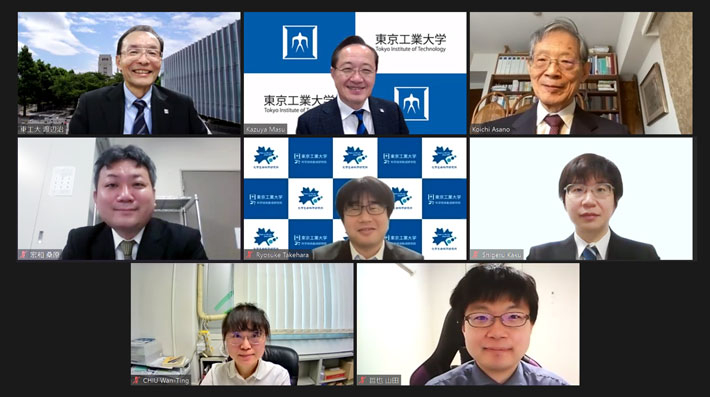Tokyo Institute of Technology, with a donation from Professor Emeritus Koichi Asano, established the ASUNARO Grant to support researchers under 45 years of age engaged in basic research. In the first call of the grant, five researchers were selected, and a ceremony to present the researchers with their award notices was held online on July 6.

(From top left) Executive Vice President for Research Watanabe, President Masu, Professor Emeritus Asano and five grant recipients
Background of ASUNARO Grant
The grant was established in FY2020, in response to Professor Emeritus Asano's wish to donate a portion of the proceeds from his research, saying, "I am grateful to society for the many years of support that allowed my work in basic research to flourish. In return, I would like to use the funds to support basic research by future generations."
Professor Emeritus Koichi Asano has studied the precise separation of multicomponent systems and developed a theoretical system for multicomponent distillation that can be applied to a wide range of temperatures, including cryogenic temperatures. He also succeeded in developing a plant for the production of "Water-18O", which is a raw material for diagnostic reagents used in PET, a method widely used in cancer screening.
First award ceremony held and five selected researchers presented their research
This is the first time the Institute has provided the grant, for which 33 researchers applied and 5 were selected as recipients.
- Shigeru KAKU
Assistant Professor / Department of Physics, School of Science
- Hirokazu KUWAHARA
Assistant Professor / Department of Life Science and Technology, School of Life Science and Technology
- Tetsuya YAMADA
Assistant Professor / Laboratory for Future Interdisciplinary Research of Science and Technology, Institute of Innovative Research
- Chiu Wan-Ting
Assistant Professor / Laboratory for Materials and Structures and Laboratory for Future Interdisciplinary Research of Science and Technology, Institute of Innovative Research
- Ryosuke TAKEHARA
Assistant Professor / Laboratory for Chemistry and Life Science, Institute of Innovative Research
At the ceremony to present the recipients with their award notices, President Kazuya Masu stated in a speech that he was looking forward to seeing the development of their research. Professor Emeritus Asano also addressed the recipients expressing high hopes for the steady development of their research activities and ultimately a fruitful outcome by the end of their long-term efforts. Following the speech, recipients presented their research and then had a deep and active discussion with Professor Emeritus Asano, President Masu, Osamu Watanabe, Executive Vice President for Research, and Kaoru Kuwata, Vice President for Research Development.
Overview of the ASUNARO Grant
Objective
The Fund is designed to provide financial support to researchers engaged in fundamental science and engineering research, including steady research in mature engineering fields, engineering research that explores new possibilities based on a long-term perspective without being influenced by trends, and original engineering research for which it is difficult to acquire funding.
Eligibility
Associate Professor, Associate Professor(Lecturer), or Assistant Professor who is employed by Tokyo Tech and under 45 years of age as of April 1, 2021. Specially Appointed Faculty is excluded.
Research support period
As a general rule, the support period is 1 year from the day the research support begins. However, depending on the research plan, it is possible to apply for a 2-year period.
Amount of support
1,000,000 yen per research proposal.
FY2021 Recipients of ASUNARO Grant
Shigeru KAKU
Assistant Professor / Department of Physics, School of Science
Research Topic
Ideal interface control for Graphene/III-V compound semiconductor hybrid materials
Research Outline
Today's comfortable society and our lives are supported by functional materials that can control electrons and light. The 2D materials discovered in recent years have novel properties not found in conventional 3D materials, so their applications as functional materials are being studied worldwide. One of them is to combine the functionality of 3D and 2D materials. Ideally, the interface between the two should be controlled to be completely clean, but such a transfer method for 2D materials has not yet been established. In this study, I develop an ideal transfer technique using an ultra-high vacuum environment.






